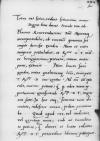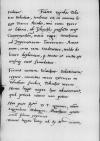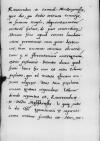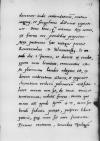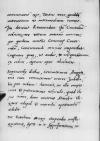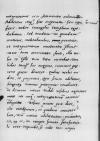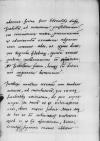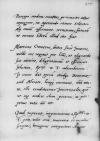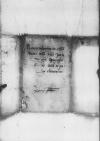Placuit, Reverendissime Domine Maecenasque incomparabilis, ab eiusmodi quamvis sat inepto dysticho exordiri. Nam et ratio temporis postulabat, et Reverendissimae Dominationis Tuae multo benignissima precatio meam anticipans extorsit. Non leviter sane gaudeo meas qualescumque litteras tantopere Tuae Reverendissimae Dominationi esse gratas, nil enim mihi optatius evenire potuit, quam quod adeo viam opportunam gratificandi Reverendissimae Dominationi Tuae ingressus si written over u⌈uii written over u⌉m. In hac itaque summa cum alacritate indefesso cursu pedem promovebo.
Quid apud nos vel audiatur, vel geratur novi, rudi ac tumultuoso potius, quam decoro et lento calamo Reverendissimae Dominationi Tuae perscribere liberius prosequor.
 BCz, 1597, p. 444
Iam tandem comitiorum tractatio initium coepit. Utinam salubria consilia patriae universae nascerentur, licet audio consultationem de republica segniter admodum et frigide attingi. Propositum erat in consilio, quanam ratione regnum possit propugnari ab impressione alicuius gravioris hostis, ut ⌊Turcae⌋. Deinde consiliarii una cum rege in eam sententiam iverunt, quippe ut quo quisquam facultatibus esset abundantior, hoc numerosius contribueret ad excitandum commune praesidium, contra – quo quisque angustiorem domi rem haberet, hoc moderatius aes conferret. Quae quidem sententia laudatae aequitatis est plena. Eiusmodi decretum ad nuntios terrarum postremo relatum est. Hii vero post multam
BCz, 1597, p. 444
Iam tandem comitiorum tractatio initium coepit. Utinam salubria consilia patriae universae nascerentur, licet audio consultationem de republica segniter admodum et frigide attingi. Propositum erat in consilio, quanam ratione regnum possit propugnari ab impressione alicuius gravioris hostis, ut ⌊Turcae⌋. Deinde consiliarii una cum rege in eam sententiam iverunt, quippe ut quo quisquam facultatibus esset abundantior, hoc numerosius contribueret ad excitandum commune praesidium, contra – quo quisque angustiorem domi rem haberet, hoc moderatius aes conferret. Quae quidem sententia laudatae aequitatis est plena. Eiusmodi decretum ad nuntios terrarum postremo relatum est. Hii vero post multam
 BCz, 1597, p. 445
animorum contentionem breviter responderunt se a suis priuilegiis ne latum unguem discessuros. Aliter respondissent, si meminissent temporibus assentiendum: quemadmodum et ⌊Cicero⌋ prudenter, in quodam eleganti loco disserit. Isti ipsi nuntii noluerunt plane iter Polonorum mercatorum ⌊Silesiam⌋ versus recludi. Hanc tamen adversam eorum voluntatem vicit auctoritas ⌊regiae maiestatis⌋, quae omnino cogitauit et mutuam vicinorum caritatem augere, et satisfacere tam enixi written over a⌈aii written over a⌉s petitionibus serenissimi ⌊regis Romanorum⌋, qui vel hac sola de causa duos legatos huc miserat. Nuper isti quoque nuntii ⌊senatores Cracovienses⌋ ab eorum congregatione dimoverunt. Et quid non agitant turbulentissimi nobilissimae plebis
BCz, 1597, p. 445
animorum contentionem breviter responderunt se a suis priuilegiis ne latum unguem discessuros. Aliter respondissent, si meminissent temporibus assentiendum: quemadmodum et ⌊Cicero⌋ prudenter, in quodam eleganti loco disserit. Isti ipsi nuntii noluerunt plane iter Polonorum mercatorum ⌊Silesiam⌋ versus recludi. Hanc tamen adversam eorum voluntatem vicit auctoritas ⌊regiae maiestatis⌋, quae omnino cogitauit et mutuam vicinorum caritatem augere, et satisfacere tam enixi written over a⌈aii written over a⌉s petitionibus serenissimi ⌊regis Romanorum⌋, qui vel hac sola de causa duos legatos huc miserat. Nuper isti quoque nuntii ⌊senatores Cracovienses⌋ ab eorum congregatione dimoverunt. Et quid non agitant turbulentissimi nobilissimae plebis
 BCz, 1597, p. 446
tribuni?
BCz, 1597, p. 446
tribuni?
Frater expulsi palatini Valachiae traditus est in manus legati Turcici ⌊Kerdei⌋ una cum uxore et liberis ab ⌊Iskryczky⌋ praefecto arcis Camyenyeczensis iussu regio. Devehitur ad ⌊imperatorem Turcarum⌋. Aiunt eum, cum iam traderetur, valde dolenter deplorasse, quod tanta et iusta spe confugii esset fraudatus.
Ferunt novum Valachiae palatinum coepisse munitas arces exstruere in Valachicis finibus ⌊Pokuczie⌋ versus. Huius legati nuper huc aduenerunt, quid petant rescire non potui.
Non puto Reverendissimam Dominationem Tuam ignorare nostram ⌊reginulam Hedvigim⌋ ⌊marchioni⌋ optatissimum ⌊filium⌋ peperisse.
Dicunt legatos ⌊Turcae⌋ ad ⌊regiam maiestatem⌋ missos
 BCz, 1597, p. 447
iam in itinere esse.
BCz, 1597, p. 447
iam in itinere esse.
Rumor hic emanavit, quod ⌊rex Ferdinandus⌋ severe mandaverit ⌊Salamancam⌋ comitem ab Orthenburg in ferreas compedes coniicere atque in perpetuum carcerem ad ⌊Novam Civitatem⌋ deportare. Causam vero huius animadversionis esse iactitant proditionem, quam inter ⌊caesarem⌋ et ⌊regem Galliae⌋ clandestina arte exercere solebat. Id an verum sit nec ne, dubito, cum propter eximiam gratiam, in qua semper apud ⌊regem Ferdinandum⌋ vir ille potens fuerat, tum quod apud ⌊Germanos⌋ sat exulceratos summam invidiam sibi conflaverit.
Nolo Reverendissimam Dominationem Tuam latere, quam egregia et probata instituta nuper in hac celeberrima ecclesia Cracoviensi magna cum laude pio exemplo eluxere.
 BCz, 1597, p. 448
Reverendus dominus ⌊Samuel Maczieyowsky⌋ ipso die, qui dedit initium comitiis, in summo templo eloquentissimam contionem habuit de pace concordiaque. Miram hinc apud omnes laudationem promeruit, cum quia dexterrime tam sacrum munus obiverit, tum quod se florentissimum antesignanum ceteris praebuerit. Breviter dicam quod sentio: unus hic iam est inter Polonos praelatos, qui ad virtutis gloriam maxime adspiret. Deus tam praeclara conanti gratiose respondeat.
BCz, 1597, p. 448
Reverendus dominus ⌊Samuel Maczieyowsky⌋ ipso die, qui dedit initium comitiis, in summo templo eloquentissimam contionem habuit de pace concordiaque. Miram hinc apud omnes laudationem promeruit, cum quia dexterrime tam sacrum munus obiverit, tum quod se florentissimum antesignanum ceteris praebuerit. Breviter dicam quod sentio: unus hic iam est inter Polonos praelatos, qui ad virtutis gloriam maxime adspiret. Deus tam praeclara conanti gratiose respondeat.
Isthunc deinde secutus est reverendus written over m⌈mss written over m⌉ dominus doctor ⌊Myschkowsky⌋. Is quoque natali die ⌊Christi⌋ gravissima et sapientissima oratione functus est. Non me
 BCz, 1597, p. 449
diocrem inde commendationem maturi ingenii et singularis doctrinae reportavit. Deus bone, quam intentus rex senior ex huius ore pendebat perpetuo. Mox postremo haec vestigia pressit reverendus dominus ⌊Vilamowsky⌋. Is natali die Sancti Ioannis et diserte et erudite grata cum lenitate concionatus est. A plurimum laudis adeptus est ex decora moderatione actionis et exquisito elegantium verborum Polonicorum artific written over t⌈tcc written over t⌉io. Licet meum non sit de tantis viris et temerarium iudicium facere, tamen quoniam mihi apud Reverendissimam Dominationem Tuam mira scribendi fiducia pateat, proferre libuit pau written over pri(?)⌈pri(?)paupau written over pri(?)⌉cis quaenam sit mea sententia. Primus oratorem, secundus theologicum
BCz, 1597, p. 449
diocrem inde commendationem maturi ingenii et singularis doctrinae reportavit. Deus bone, quam intentus rex senior ex huius ore pendebat perpetuo. Mox postremo haec vestigia pressit reverendus dominus ⌊Vilamowsky⌋. Is natali die Sancti Ioannis et diserte et erudite grata cum lenitate concionatus est. A plurimum laudis adeptus est ex decora moderatione actionis et exquisito elegantium verborum Polonicorum artific written over t⌈tcc written over t⌉io. Licet meum non sit de tantis viris et temerarium iudicium facere, tamen quoniam mihi apud Reverendissimam Dominationem Tuam mira scribendi fiducia pateat, proferre libuit pau written over pri(?)⌈pri(?)paupau written over pri(?)⌉cis quaenam sit mea sententia. Primus oratorem, secundus theologicum
 BCz, 1597, p. 450
contionatorem egit, tertius vero quiddam interiectum et intermedium tenuit. Ita decrevit reverendissimus ⌊episcopus Cracoviensis⌋ redintegrare veterem maiorum morem, qui quidem cunctis canonicis Cracoviensibus concionandi munus imponebat. Cogentur quoque, ut audio u, reliqui canonici ex ordine coeptum opus absolvere.
BCz, 1597, p. 450
contionatorem egit, tertius vero quiddam interiectum et intermedium tenuit. Ita decrevit reverendissimus ⌊episcopus Cracoviensis⌋ redintegrare veterem maiorum morem, qui quidem cunctis canonicis Cracoviensibus concionandi munus imponebat. Cogentur quoque, ut audio u, reliqui canonici ex ordine coeptum opus absolvere.
Superioribus diebus serenissimus ⌊Augustus⌋ una cum serenissima sorore ⌊Isabella⌋ bis per urbem decurrit in illo comptissimo et pretiosissimo vehiculo, quod elapso anno dono miserat marchio. Elegans – edepol – et iucundum spectaculum edidit.
De Puteolani st agri stupenda conflagratione Reverendissimae Dominationi Tuae significassem, ni
 BCz, 1597, p. 451
ex written over ...⌈... illegible⌈...... illegible⌉exex written over ...⌉ ⌊Mauritio⌋ cognovissem iamdudum haec Reverendissimae Dominationi Tuae esse nota.
BCz, 1597, p. 451
ex written over ...⌈... illegible⌈...... illegible⌉exex written over ...⌉ ⌊Mauritio⌋ cognovissem iamdudum haec Reverendissimae Dominationi Tuae esse nota.
Scribitur mihi ex ⌊Bononia⌋, quod sub id tempus in ⌊Graecia⌋ horribilia quaedam ostenta in aere apparuerint: utpote armatae acies acriter conflictantes.
Illud pene praetermississem, quod maxime Reverendissimam Dominationem Tuam scire cupii. Praeteritis mensibus quid in ⌊Silesia⌋ prope ⌊Legnitium⌋ acciderit, audiat. Ferunt caco written over a⌈aoo written over a⌉daemonem sub honesti viri persona convenisse quendam adulescentem et solicitasse, ut sibi a servitio esset; pingui mercede proposita in suum famulatum perduxisse hac vero sola universi servitii summa indicata, quippe ut quandocumque sacris contionibus interesset, tantummodo ipsum evangelium audiret, porro ab omni reliqua
 BCz, 1597, p. 452
interpretatione sese festinanter submovere written over a⌈arere written over a⌉t. Adolescens itaque, ut narratur on the margin⌈ut narraturut narratur on the margin⌉, haec imperata heri saepius fecit. Audito evangelio templum egrediebatur. Sed tandem in quadam contione meditabundus cons perstitit ac interpretationi constanter praebuit aures. Tum concionator forte illa verba ex epistula ⌊Divi Petri⌋ recitabat: “Diabolus tamquam leo rugiens circumit, quaerens, quem devoret” Quibus verbis auditis et perpensis coepit secum adulescens diligentius Domini praescripta revolvere ac demum meras diaboli insidias agnoscere on the margin in place of crossed-out visse⌈vissescerescere on the margin in place of crossed-out visse⌉, nec umquam interpre written over a⌈aee written over a⌉tationem sacram reliquit written over sse⌈ssett written over sse⌉. Dehinc paucos post dies ille cacodaemon in quodam montoso loco iterum accessit adulescentem. Percunctatus est ex eo, an recepto servitio satisfaceret. Is vero respondit se nolle tam impio
BCz, 1597, p. 452
interpretatione sese festinanter submovere written over a⌈arere written over a⌉t. Adolescens itaque, ut narratur on the margin⌈ut narraturut narratur on the margin⌉, haec imperata heri saepius fecit. Audito evangelio templum egrediebatur. Sed tandem in quadam contione meditabundus cons perstitit ac interpretationi constanter praebuit aures. Tum concionator forte illa verba ex epistula ⌊Divi Petri⌋ recitabat: “Diabolus tamquam leo rugiens circumit, quaerens, quem devoret” Quibus verbis auditis et perpensis coepit secum adulescens diligentius Domini praescripta revolvere ac demum meras diaboli insidias agnoscere on the margin in place of crossed-out visse⌈vissescerescere on the margin in place of crossed-out visse⌉, nec umquam interpre written over a⌈aee written over a⌉tationem sacram reliquit written over sse⌈ssett written over sse⌉. Dehinc paucos post dies ille cacodaemon in quodam montoso loco iterum accessit adulescentem. Percunctatus est ex eo, an recepto servitio satisfaceret. Is vero respondit se nolle tam impio
 BCz, 1597, p. 453
oneri mancipare. Cumque diabolus immensa pecuniarum copia promissa conaretur persuadere, adulescens subito se procul salvus praecipitavit. Inde cacodaemon evanuit ac admirandus strepitus in aere exortus est: deciditque celeri casu maxima vis carbonum. Adolescens visis his in urbem properavit et rem omnem exposuit, atque multos eduxit ad conspiciendum acervum carbonum. Id non solum ore circumfertur, sed et typis excuditur, ut ex parente accepi. Quid, si et Lutherani prisca monachorum insomnia imitari incipiant?
BCz, 1597, p. 453
oneri mancipare. Cumque diabolus immensa pecuniarum copia promissa conaretur persuadere, adulescens subito se procul salvus praecipitavit. Inde cacodaemon evanuit ac admirandus strepitus in aere exortus est: deciditque celeri casu maxima vis carbonum. Adolescens visis his in urbem properavit et rem omnem exposuit, atque multos eduxit ad conspiciendum acervum carbonum. Id non solum ore circumfertur, sed et typis excuditur, ut ex parente accepi. Quid, si et Lutherani prisca monachorum insomnia imitari incipiant?
Reginula ⌊Isabella⌋ nubit ⌊regi Ioanni⌋, qui quidem huc mittit pro abducenda ux written over ...⌈... illegible⌈...... illegible⌉uxux written over ...⌉ore quattuor legatos numerosissimo et splendidissimo cum comitatu. Propediem
 BCz, 1597, p. 454
aderunt. Fertur hisce liberalibus diebus ⌊Isabellam⌋ ad ⌊maritum⌋ profecturam, cum serenissima ⌊mater⌋ preciosissimum et admirandum ornatum adparari iam curavit, adeo, ut saepius dicat, pro reginula ⌊Hedvigi⌋, sponsum venisse quidem excellentissimo cum com written over equ⌈equcomcom written over equ⌉itatu, e written over a⌈aee written over a⌉t Isabellam suam longe cum ditissimo apparatu discessuram.
BCz, 1597, p. 454
aderunt. Fertur hisce liberalibus diebus ⌊Isabellam⌋ ad ⌊maritum⌋ profecturam, cum serenissima ⌊mater⌋ preciosissimum et admirandum ornatum adparari iam curavit, adeo, ut saepius dicat, pro reginula ⌊Hedvigi⌋, sponsum venisse quidem excellentissimo cum com written over equ⌈equcomcom written over equ⌉itatu, e written over a⌈aee written over a⌉t Isabellam suam longe cum ditissimo apparatu discessuram.
Intellexi nuntios terrarum iam tandem accessisse ad contributionem pro cuiusque facultatibus aestimatam, de qua suprascripsi, ita tamen, ut et ecclesiasticus ordo idem oneris subeat. Nunc itaque de hac re cum ecclesiasticis tractatur. Quod si et hii assentientur, brevi comitiis suprema manus addetur.
 BCz, 1597, p. 455
Percepi eosdem nuntios pertinaciter adhuc repugnare in aperiendo itinere Silesitico. Alii tamen affirmant certissimo futurum, ut rursus liberum illud iter fiat.
BCz, 1597, p. 455
Percepi eosdem nuntios pertinaciter adhuc repugnare in aperiendo itinere Silesitico. Alii tamen affirmant certissimo futurum, ut rursus liberum illud iter fiat.
⌊Martinus Cromerus⌋, doctus sane iuvenis, valde me rogavit per litteras, ut aliquando suo nomine diligentissimam et officiosissimam salutem Reverendissimae Dominationi Tuae adscriberem. Is nunc dat operam studiis ⌊Bononiae⌋, sub Alciato, longe omnium nostra aetate illo eruditissimo iureconsulto, quem ut ego audire olim possim, in perpetuis votis mihi est.
Quod superest, impensissime a Reverendissima Dominatione Tua peto, velit mea temeraria et inculta scripta benignius interpretari ac paper damaged⌈[c]c paper damaged⌉ me
 BCz, 1597, p. 456
pollicita gratia complecti, quam quidem maximi facio. Iam vero mea obsequia et promptissima et creberrima Reverendissimae Dominationi Tuae dedico. Quam Deus Immortalis
optime incolumem, hilarem et felicem diu conservet. Huic me iterum atque iterum trado et commendo.
BCz, 1597, p. 456
pollicita gratia complecti, quam quidem maximi facio. Iam vero mea obsequia et promptissima et creberrima Reverendissimae Dominationi Tuae dedico. Quam Deus Immortalis
optime incolumem, hilarem et felicem diu conservet. Huic me iterum atque iterum trado et commendo.
 BCz, 1597, p. 444
Iam tandem comitiorum tractatio initium coepit. Utinam salubria consilia patriae universae nascerentur, licet audio consultationem de republica segniter admodum et frigide attingi. Propositum erat in consilio, quanam ratione regnum possit propugnari ab impressione alicuius gravioris hostis, ut
BCz, 1597, p. 444
Iam tandem comitiorum tractatio initium coepit. Utinam salubria consilia patriae universae nascerentur, licet audio consultationem de republica segniter admodum et frigide attingi. Propositum erat in consilio, quanam ratione regnum possit propugnari ab impressione alicuius gravioris hostis, ut  BCz, 1597, p. 445
animorum contentionem breviter responderunt se a suis priuilegiis ne latum unguem discessuros. Aliter respondissent, si meminissent temporibus assentiendum: quemadmodum et
BCz, 1597, p. 445
animorum contentionem breviter responderunt se a suis priuilegiis ne latum unguem discessuros. Aliter respondissent, si meminissent temporibus assentiendum: quemadmodum et  BCz, 1597, p. 446
tribuni?
BCz, 1597, p. 446
tribuni?
 BCz, 1597, p. 447
iam in itinere esse.
BCz, 1597, p. 447
iam in itinere esse.
 BCz, 1597, p. 448
Reverendus dominus
BCz, 1597, p. 448
Reverendus dominus  BCz, 1597, p. 449
diocrem inde commendationem maturi ingenii et singularis doctrinae reportavit. Deus bone, quam intentus rex senior ex huius ore pendebat perpetuo. Mox postremo haec vestigia pressit reverendus dominus
BCz, 1597, p. 449
diocrem inde commendationem maturi ingenii et singularis doctrinae reportavit. Deus bone, quam intentus rex senior ex huius ore pendebat perpetuo. Mox postremo haec vestigia pressit reverendus dominus  BCz, 1597, p. 450
contionatorem egit, tertius vero quiddam interiectum et intermedium tenuit. Ita decrevit reverendissimus
BCz, 1597, p. 450
contionatorem egit, tertius vero quiddam interiectum et intermedium tenuit. Ita decrevit reverendissimus  BCz, 1597, p. 451
ex written over ...⌈... illegible⌈...... illegible⌉exex written over ...⌉
BCz, 1597, p. 451
ex written over ...⌈... illegible⌈...... illegible⌉exex written over ...⌉  BCz, 1597, p. 452
interpretatione sese festinanter submovere written over a⌈arere written over a⌉t. Adolescens itaque, ut narratur on the margin⌈ut narraturut narratur on the margin⌉, haec imperata heri saepius fecit. Audito evangelio templum egrediebatur. Sed tandem in quadam contione meditabundus cons perstitit ac interpretationi constanter praebuit aures. Tum concionator forte illa verba ex epistula
BCz, 1597, p. 452
interpretatione sese festinanter submovere written over a⌈arere written over a⌉t. Adolescens itaque, ut narratur on the margin⌈ut narraturut narratur on the margin⌉, haec imperata heri saepius fecit. Audito evangelio templum egrediebatur. Sed tandem in quadam contione meditabundus cons perstitit ac interpretationi constanter praebuit aures. Tum concionator forte illa verba ex epistula  BCz, 1597, p. 453
oneri mancipare. Cumque diabolus immensa pecuniarum copia promissa conaretur persuadere, adulescens subito se procul salvus praecipitavit. Inde cacodaemon evanuit ac admirandus strepitus in aere exortus est: deciditque celeri casu maxima vis carbonum. Adolescens visis his in urbem properavit et rem omnem exposuit, atque multos eduxit ad conspiciendum acervum carbonum. Id non solum ore circumfertur, sed et typis excuditur, ut ex parente accepi. Quid, si et Lutherani prisca monachorum insomnia imitari incipiant?
BCz, 1597, p. 453
oneri mancipare. Cumque diabolus immensa pecuniarum copia promissa conaretur persuadere, adulescens subito se procul salvus praecipitavit. Inde cacodaemon evanuit ac admirandus strepitus in aere exortus est: deciditque celeri casu maxima vis carbonum. Adolescens visis his in urbem properavit et rem omnem exposuit, atque multos eduxit ad conspiciendum acervum carbonum. Id non solum ore circumfertur, sed et typis excuditur, ut ex parente accepi. Quid, si et Lutherani prisca monachorum insomnia imitari incipiant?
 BCz, 1597, p. 454
aderunt. Fertur hisce liberalibus diebus
BCz, 1597, p. 454
aderunt. Fertur hisce liberalibus diebus  BCz, 1597, p. 455
Percepi eosdem nuntios pertinaciter adhuc repugnare in aperiendo itinere Silesitico. Alii tamen affirmant certissimo futurum, ut rursus liberum illud iter fiat.
BCz, 1597, p. 455
Percepi eosdem nuntios pertinaciter adhuc repugnare in aperiendo itinere Silesitico. Alii tamen affirmant certissimo futurum, ut rursus liberum illud iter fiat.
 BCz, 1597, p. 456
pollicita gratia complecti, quam quidem maximi facio. Iam vero mea obsequia et promptissima et creberrima Reverendissimae Dominationi Tuae dedico. Quam Deus Immortalis
optime incolumem, hilarem et felicem diu conservet. Huic me iterum atque iterum trado et commendo.
BCz, 1597, p. 456
pollicita gratia complecti, quam quidem maximi facio. Iam vero mea obsequia et promptissima et creberrima Reverendissimae Dominationi Tuae dedico. Quam Deus Immortalis
optime incolumem, hilarem et felicem diu conservet. Huic me iterum atque iterum trado et commendo.
